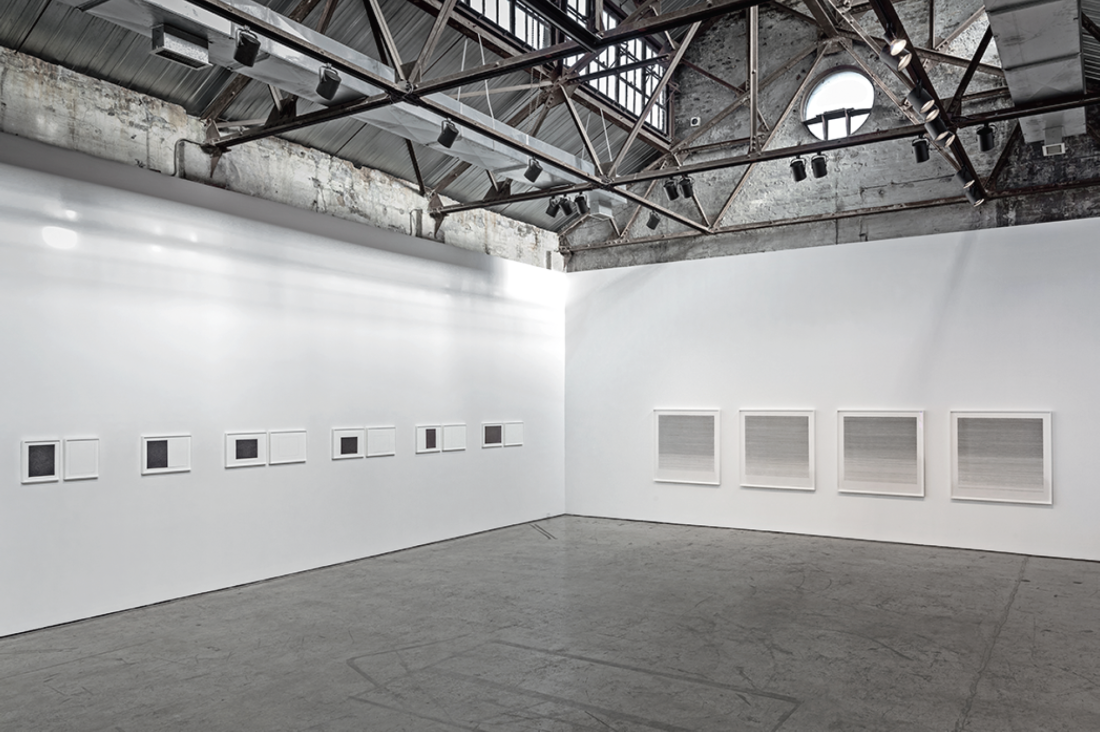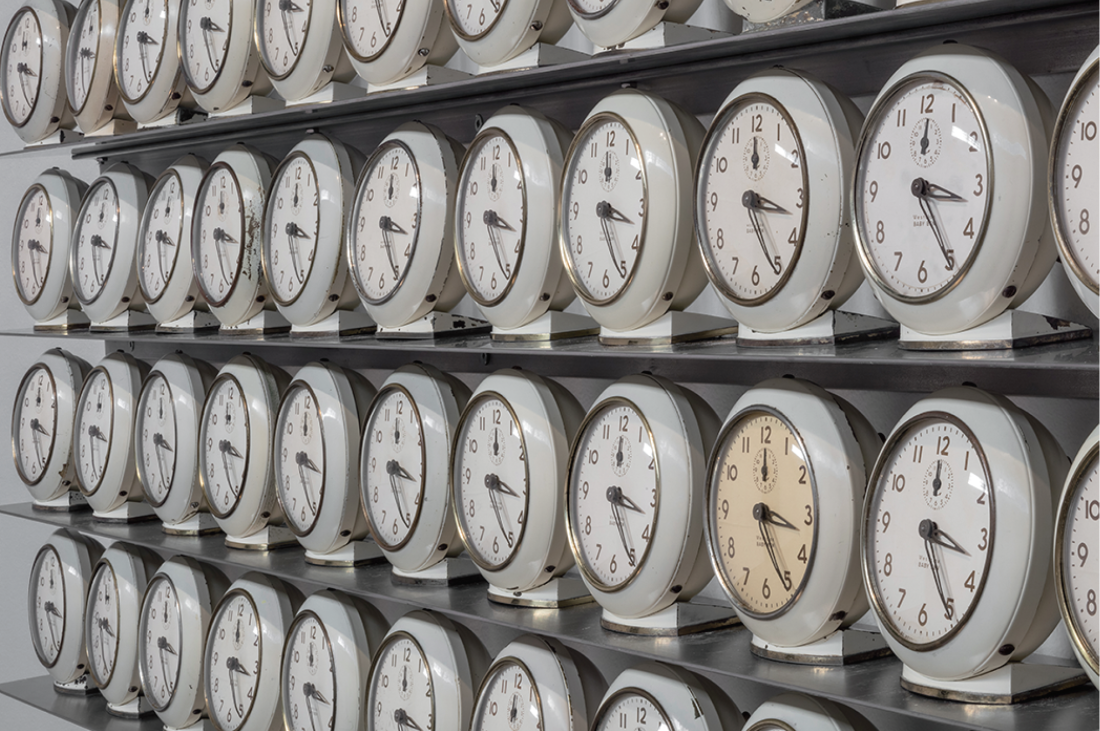Ken Nicol
It’s hard not to sound hyperbolic when describing Ken Nicol’s feverish solo exhibition at the Olga Korper Gallery in Toronto. In fact, upon leaving the gallery I felt an overwhelming urge to transcribe the exhibition immediately into words because, as Nicol persistently reminds us, it’s ending one minute at a time. On your left as you enter the gallery, one hundred Westclox Baby Ben clocks are arranged tidily along five long shelves. Their ever so slightly asynchronous whispers of seconds past provide the soundtrack to the ninety-three and a half day letter beside it, a piece of paper folded again and again and kept in Nicol’s pants pockets for (of course) ninety-three and a half days. Perfectly paired, these pieces give us experiences of time that are all three auditory, visual and tactile.

Installation view, Ken Nicol, “…and it’s ending one minute at a time,” 2015, Olga Korper Gallery, Toronto. Photograph Tony Hafkensheid. Courtesy Olga Korper Gallery, Toronto.
Four large works comprise flogging a dead horse, taking up another wall of the gallery. Representing the course of seasons, paper covered in tallies mark days gone by until the pen has run dry. The paper has been meticulously divided beforehand with the beginning and end date of each series of markings inscribed lightly in pencil in the upper left and lower right hand corners of the paper. The result is a mesmerizing meditation on both personal timekeeping and the spatial comprehension of the temporal. Each of the dead horses—uni-ball Deluxe Micro Pens—is displayed in a row on pedestals to the right of the four framed works. In one part of the series, the pen dies and then regains its life or ink to come back for a few more rows. In those rows, Nicol incises the paper with the un-inked point of the pen. The indents in the weave of the paper wait for the ink’s appearance, almost as if the ink were once there and has been taken away. Pens parade as horses, underlining Nicol’s conception of motion through time as motion across space.
In Autobiography of Red, Anne Carson’s winged red monster Geryon asks, What is time made of? His interlocutor replies, Time isn’t made of anything. It is an abstraction. Just a meaning that we impose upon motion. We find this impulse echoed in Nicol’s work where mark making acts as an imposition of meaning upon motion. The exhibition is monochrome, albeit for the red of the typewriter ribbon; Nicol, like the monster-boy of Carson’s prose poem, interrogates colour through its lack. White is black. Black is white. Perhaps soon I will get some new information about red.

Ken Nicol, One Hundred of the Same Clock, 2015, 100 Westclox Baby Bens, model 61v, 21.5 x 80 inches. Photograph Tony Hafkensheid. Courtesy Olga Korper Gallery, Toronto.
Fifty-five framed sheets of paper take up the next wall with the phrase “this is your life and it’s ending one minute at a time” typed over and over again to fill each page. Consisting of 55 characters, the phrase forms a series of mesmerizing patterns as Nicol shifts the margin of his typewriter by one character with each page. Each string of letters gets longer and thinner as we move along the series. Every 10 pages, Nicol removed the inked ribbon from his typewriter to make a blank page, pressing the keys of the typewriter into a sheet of paper, rubbing off the residual ink as the page progresses. This series of four (10, 20, 30, 40) is shown together on another wall. Keeping with the theme of instrument-and-product, the exhausted typewriter ribbon is shown alongside the 55 pieces, as is the correction tape used during the process of creating the larger series. In these works, the uniformity of the rigid lines of text comes undone as if from exhaustion, with mistaken letters tumbling over the tape. The inked pages are called This is your life… and the un-inked …and it’s ending one minute at a time. Together they form a whole, making up the negative and positive halves of the phrase and the formal qualities of the works themselves: inked and the lack thereof.
Nicol’s obsessive conceptualization of the passage of time and mark-making processes feel perfectly at home in the space of the Olga Korper Gallery, a building whose history traces the path between industry and art. The steel beams and glass ceiling of the former foundry and mattress factory cap the exhibition as if extending the lines on paper. Nicol’s work embodies both industry and the well-trodden languages of minimalism and conceptualism, leaving us with a vision of labour and grace of movement. Foregrounding will, process and concept, Nicol echoes the theory of making laid out by Sol LeWitt’s essay, “Sentences on Conceptual Art.” Treading from concept to idea and at heart a giant exercise in keeping time (in our bodies, our minds and on paper) it remains difficult to tell whether one is sped up or relaxed by Nicol’s meditation. Despite the obsessive control Nicol exacts throughout the exhibition, the resounding affect is one of frenzy and speed. To exit—pass once more by the whisper of the clocks. ❚
“…and it’s ending one minute at a time” was exhibited at Olga Korper Gallery, Toronto, from September 30 to October 31, 2015.
Emily Doucet is a writer and researcher currently working towards a PhD in the history of photography at the University of Toronto.

